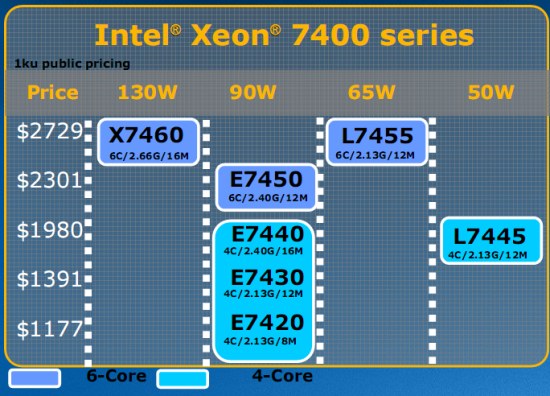Intel Xeon 7460: Six Cores to Bulldoze Opteron
by Johan De Gelas on September 23, 2008 12:00 AM EST- Posted in
- IT Computing
Price Comparisons
Clearly, six cores and 16MB of L3 cache does not come cheap:

Pricing and TDP of the Xeon 74xx series
Let us see how this compares with the current AMD pricing, which AMD has not updated since March 2008.
| Server CPU Pricing | |||
| Intel CPU | Price | AMD CPU | Price |
| Xeon X7460 2.66GHz (6 core, 16MB) | $2729 | ||
| Xeon E7450 2.4GHz (6 Core, 12MB) | $2301 | Opteron 8360 SE 2.5GHz | $2149 |
| Xeon E7440 2.4GHz (12MB) | $1980 | Opteron 8358 SE 2.4GHz | $1865 |
| Xeon E7430 2.13GHz (12MB) | $1391 | Opteron 8356 2.3GHz | $1514 |
| Xeon E7420 2.13GHz (8MB) | $1177 | Opteron 8354 2.2GHz | $1165 |
| Opteron 8350 2.0GHz | $873 | ||
| Xeon L7455 2.13GHz (6 core, 12MB) | $2729 | ||
| Xeon L7445 2.13GHz (12MB) | $1980 | Opteron 8347 HE 1.9GHz | $873 |
If we use the numbers from our quad socket comparison, it is clear that the two top models of the newest Xeons are out of reach of AMD. You might remember that a 2.5GHz Opteron 8360 performs more or less at the level of a 2.93GHz Xeon X7350. The E7450 that replaces the X7350 has six improved cores and a massive 12MB L3, which should ensure the newest Xeon easily outperforms the X7350 despite having a clock speed disadvantage of about 20%. Intel remains stubborn when it comes to the lower power CPUs, which come with a huge price premium. This leaves a small opening for AMD with its upcoming 45nm Shanghai CPUs.










34 Comments
View All Comments
JarredWalton - Tuesday, September 23, 2008 - link
Heh... that's why I love the current IBM commercials."How much will this save us?"
"It will reduce our power bills by up to 40%."
"How much did we spend on power?"
"Millions."
[Cue happy music....]
What they neglect to tell you is that in order to achieve the millions of dollars in energy savings, you'll need to spend billions on hardware upgrades first. They also don't tell you whether the new servers are even faster (it's presumed, but that may not be true). Even if your AC costs double the power bills for a server, you're still only looking at something like $800 per year per server, and the server upgrades cost about 20 times as much every three to five years.
Now, if reduced power requirements on new servers mean you can fit more into your current datacenter, thus avoiding costly expansion or remodeling, that can be a real benefit. There are certainly companies that look at density as the primary consideration. There's a lot more to it than just performance, power, and price. (Support and service comes to mind....)
Loknar - Wednesday, September 24, 2008 - link
Not sure what you mean: "reduced power requirements means you can fit more into your DC". You can fill your slots regardless of power, unless I'm missing something.Anyway I agree that power requirement is the last thing we consider when populating our servers. It's good to save the environment, that's all. I don't know about other companies, but for critical servers, we buy the most performing systems, with complete disregard of the price and power consumption; because the cost of DC rental, operation (say, a technician earns more than 2000$ per year, right?) and benefits of performance will outweigh everything. So we're so happy AMD and Intel have such a fruitful competition. (And any respectable IT company is not fooled by IBM's commercial! We only buy OEM (Dell in my case) for their fast 24-hour replacement part service and worry free feeling).
JarredWalton - Wednesday, September 24, 2008 - link
I mean that if your DC has a total power and cooling capacity of say 100,000W, you can "only" fit 2000 500W servers in there, or you could fit 4000 250W servers. If you're renting rack space, this isn't a concern - it's only a concern for the owners of the data center itself.I worked at a DC for a while for a huge corporation, and I often laughed (or cried) at some of their decisions. At one point the head IT people put in 20 new servers. Why? Because they wanted to! Two of those went into production after a couple months, and the remainder sat around waiting to be used - plugged in, using power, but doing no actual processing of any data. (They had to use up the budget, naturally. Never mind that the techs working at the DC only got a 3% raise and were earning less than $18 per hour; let's go spend $500K on new servers that we don't need!)